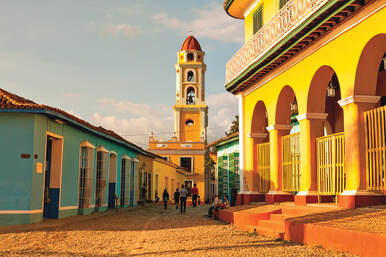Located in South Central Cuba, 195 miles from Havana, is the town of Trinidad.
 Colonial Trinidad
Colonial Trinidad
Trinidad is very rich in history and architecture. Founded in 1514, Trinidad is a unique colonial town with cobblestone streets. The old historical center of Trinidad is the best to see on foot, cars aren't allowed anyway. Trinidad earned an infamous history as a slave-trade center. Thousands of slaves were traded from this city to toil in other islands of the Caribbean. In 1988 UNESCO declared Trinidad a "World Monument.” Its neo-baroque main square, Plaza Mayor, is surrounded by grand colonial buildings. Trinidad is an absolute must! Stunning outdoor nightlife, nature and beach.
Trinidad offers a well-preserved view of old world Cuba. Called “the museum city of Cuba,” Trinidad is a window into the past. Red tile roofs atop pastel stucco structures line the cobblestone streets. This port town reflects its XVI century past through its architecture. XVIII century smugglers and pirates made frequent calls here or even used this port as their base of operations in the Caribbean. The wealth and importance of Trinidad continued into the XIX century when sugar barons reigned. As you tour Trinidad, make stops at the Museo Romántico, in the restored Palacio Brunet mansion, the Museo de Arquitectura Colonial, displaying relics from the town’s sugar-producing era, and the Iglesia de la Santísima, the 19th-century cathedral with a vaulted ceiling and carved altars.
Trinidad is simply unique! This gem of central Cuba was the third Spanish settlement in the country. UNESCO declared Trinidad to be a part of world cultural heritage because of its colonial architecture, which dates from the 18th, 19th and early 20th centuries. The oldest part of the city (55 blocks in size, with 1211 buildings) is one of its greatest attractions. It contains beautiful churches (such as the Great Parish Church, a neoclassical edifice built in 1892) and public squares, the most important of which is Main Square-surrounded by buildings of great beauty and historic and architectural interest and considered the second most important square in the country, after Havana's Cathedral Square.
In addition to its beautiful colonial presentation, Trinidad is located by the sea and has two amazing beaches--Ancon and María Aguilar. Ancon Beach is just a little over 7 miles from the city and it is two and half miles long, with white sand and green-blue water. Its seabed is ideal for scuba diving.
Follow the rhythm and move to Salsa Cubana! If you want to enjoy some Salsa dancing, Trinidad is the place to do it. As you tour Trinidad, you will see some signs for Salsa lessons. Locals will enjoy teaching you the moves for Salsa the Cuban style, from beginners to advanced. If you thought you could never learn salsa, you will be proven wrong.
Enjoy Trinidad’s cultural richness--mingle with local residents and call on artists in their studios as you wind your way through the city. If you enjoy photography, Trinidad has perfect spots for beautiful photos and memories. You can’t cruise Cuba and not stop at Trinidad!
Trinidad offers a well-preserved view of old world Cuba. Called “the museum city of Cuba,” Trinidad is a window into the past. Red tile roofs atop pastel stucco structures line the cobblestone streets. This port town reflects its XVI century past through its architecture. XVIII century smugglers and pirates made frequent calls here or even used this port as their base of operations in the Caribbean. The wealth and importance of Trinidad continued into the XIX century when sugar barons reigned. As you tour Trinidad, make stops at the Museo Romántico, in the restored Palacio Brunet mansion, the Museo de Arquitectura Colonial, displaying relics from the town’s sugar-producing era, and the Iglesia de la Santísima, the 19th-century cathedral with a vaulted ceiling and carved altars.
Trinidad is simply unique! This gem of central Cuba was the third Spanish settlement in the country. UNESCO declared Trinidad to be a part of world cultural heritage because of its colonial architecture, which dates from the 18th, 19th and early 20th centuries. The oldest part of the city (55 blocks in size, with 1211 buildings) is one of its greatest attractions. It contains beautiful churches (such as the Great Parish Church, a neoclassical edifice built in 1892) and public squares, the most important of which is Main Square-surrounded by buildings of great beauty and historic and architectural interest and considered the second most important square in the country, after Havana's Cathedral Square.
In addition to its beautiful colonial presentation, Trinidad is located by the sea and has two amazing beaches--Ancon and María Aguilar. Ancon Beach is just a little over 7 miles from the city and it is two and half miles long, with white sand and green-blue water. Its seabed is ideal for scuba diving.
Follow the rhythm and move to Salsa Cubana! If you want to enjoy some Salsa dancing, Trinidad is the place to do it. As you tour Trinidad, you will see some signs for Salsa lessons. Locals will enjoy teaching you the moves for Salsa the Cuban style, from beginners to advanced. If you thought you could never learn salsa, you will be proven wrong.
Enjoy Trinidad’s cultural richness--mingle with local residents and call on artists in their studios as you wind your way through the city. If you enjoy photography, Trinidad has perfect spots for beautiful photos and memories. You can’t cruise Cuba and not stop at Trinidad!